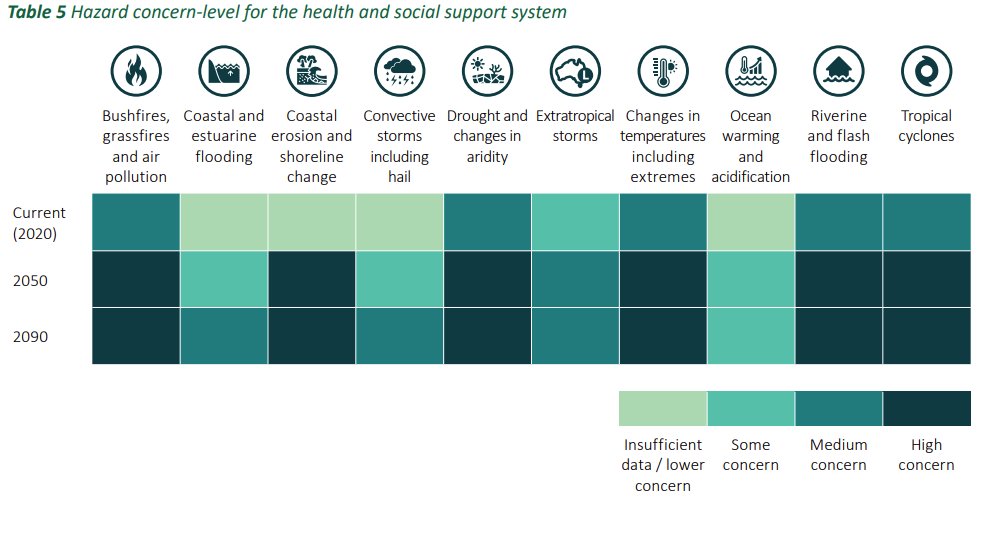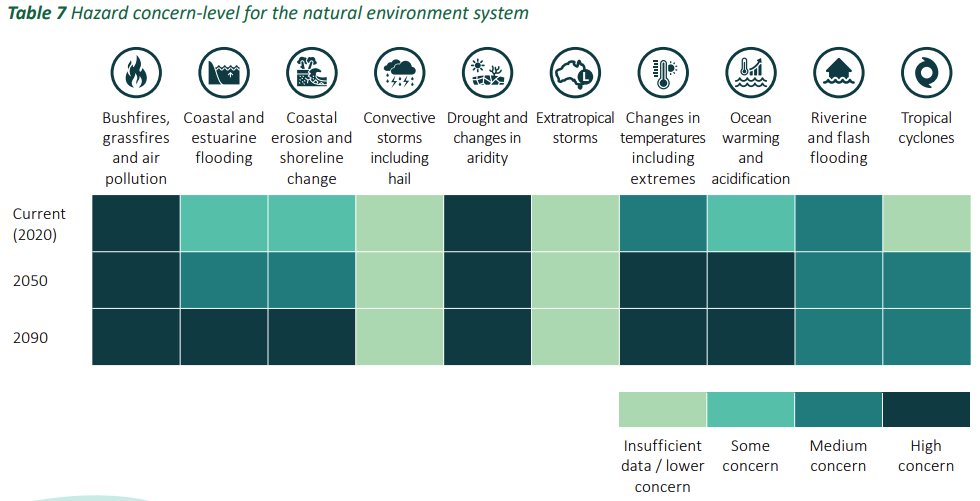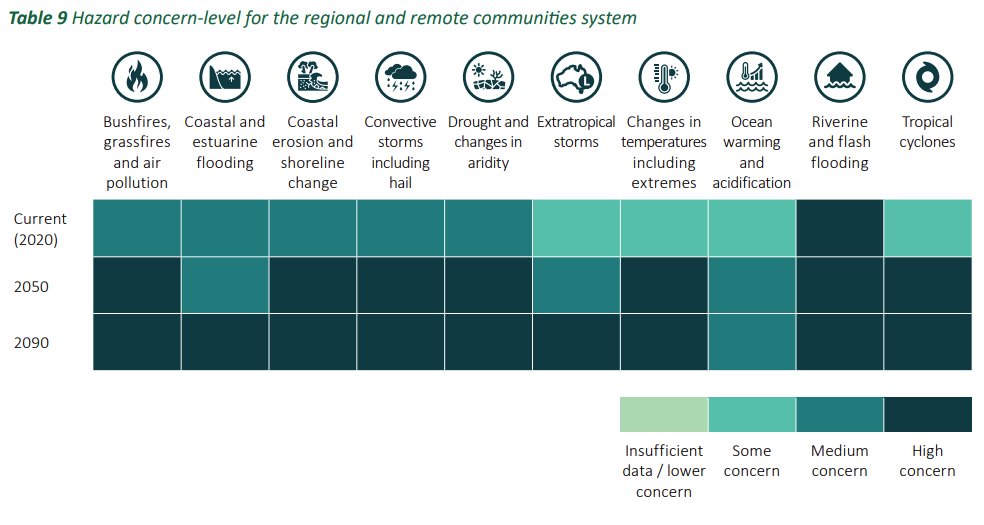
On March 12 the Assistant Climate Change Minister Senator Jenny McAllister released Australia’s first National Climate Risk Assessment report. It identifies 56 nationally significant climate risks facing Australia in a broad first pass assessment. A second phase report currently underway will focus on 11 high profile risks that were identified.
Priority risks cover the natural environment; primary industries and food; regional and remote communities; health and social support; infrastructure; defence and national security; communities and settlement; water security; supply chains; economy, trade and finance; and governance.
A report on First Nations climate risks required more time and is also underway.
The final National Climate Risk Assessment report will be released after the second pass risk assessment report is completed.
A National Climate Risk Assessment and developing a National Adaptation Plan was an election promise of the Albanese Government in 2022.
Australia’s climate is warming with area wide temperatures now at 1.5C above pre-industrial conditions. Australia is feeling the heat with heatwaves, bushfires, more intense rainfall, floods, cyclones, droughts, marine heatwaves.
In launching the report Jenny McAllister said the first pass report was a key milestone for developing national climate adaptation plan:
“Australians know that the climate has changed. They feel it on hotter days and experience it in extreme weather events which occur more frequently. This work will help us better prepare for the small and big challenges that climate change brings.
“While the former government refused to accept the science, the Albanese Government is acting to identify and manage risks from climate change.”
“This National Climate Risk Assessment is long overdue. It provides an evidence-based national picture of the emerging risks climate change poses to Australia’s community, assets and services,” Assistant Minister McAllister said.
“We will continue to do everything we can to reduce our emissions and limit the impact of climate change. However we must also take steps to protect Australia’s economy, society and natural environment from the changes scientists tell are already locked in.
“Adapting to risk is a task for all of us. We’re laying the foundation for all levels of government, businesses, communities and First Nations to better understand these risks and take action to build their resilience.”
Ministerial Media Release 12 March
Second pass assessment risks
Defence and national security
Risks to domestic disaster response and recovery assistance from the competing need to respond to multiple natural hazard events as well as national security contingencies, resulting in concurrency pressures and overwhelming the Government’s capacity to respond effectively.
Significant climate risks for Defence and Security include:
- Disaster response and recovery: Risks to domestic disaster response and recovery assistance from the competing need to respond to multiple natural hazard events as well as national security contingencies, resulting in concurrency pressures and overwhelming the Government’s capacity to respond effectively.
- Migration and displacement: Risks to the Government’s ability to manage movements of people (both domestically and internationally) that may cause border security risks or undermine social cohesion.
- Social cohesion: Risks to social cohesion that cause polarised or fearful social environments, leading to domestic security challenges and civil unrest.
- Natural environments: Risks to natural environments that cause changes in species migration, communicable diseases, and resource availability, increasing pressure on the protection and maintenance of borders.
- Critical infrastructure: Risks to critical and essential infrastructure and Defence assets including loss of function due to direct climate impacts and vulnerabilities from flow-on effects.
- Personnel health and safety: Risks to personnel health and safety that limit workforce productivity and periodically limit operations and training.
- Supply chains: Risks to supply chains that support national security agencies, reducing sovereign capability, productivity and causing instability in trade alliances and negotiations.
- Essential services: Risks to essential services and logistics systems (including, food, energy and water) necessary for national security agencies to operate.

Health and social support
Risks to health and wellbeing from slow onset and extreme climate impacts.
Significant climate risks – health and social support system include:
- Individuals and communities at risk: Risks to health and wellbeing of individuals and communities in exposed and vulnerable situations that increase inequity as a result of impacts on the wider determinants of health, and reduce access to health and social support services
- Heat and extreme weather: Risks to health and wellbeing from slow onset and extreme climate impacts including increasing temperatures, heat extremes, storms, floods, and bushfires.
- Mental health: Risks to mental health and wellbeing including post-disaster trauma, climate anxiety, and a lost sense of belonging and connection to Country.
- Service delivery and workforce: Risks to delivery of health and social support services and the health workforce that are caused by increased demand, cost and disruptions.
- Air quality: Risks to health and wellbeing from aeroallergens and worsening indoor and outdoor air quality.
- Communicable diseases: Risks to health and wellbeing from the emergence and increased transmission of communicable diseases.
- Food and water security: Risks to health and wellbeing from compromised ecosystem services that support food and water security.
- Infrastructure: Risks to physical health and care infrastructure that affect the accessibility of healthcare and social support resources.
- First Nations: Risks to health and wellbeing of First Nations peoples that increase food, water, energy and housing insecurity, and impact connection to Country.

Infrastructure and built environment
Risks to critical infrastructure that impact access to essential services.
Significant climate risks for Infrastructure and Built environment include:
- Buildings and community infrastructure: Risks to the resilience of buildings and community infrastructure that arise from constraints in regulations, including urban planning, and the increasing pressures from domestic migration, affecting community resilience and movement.
- Transport and telecommunications: Risks to transport and telecommunication assets and infrastructure that disrupt critical supply chains, connectivity, the movement of people and emergency responses.
- Human health, medical and emergency services: Risks to human health, and medical and emergency services that damage and disrupt critical health facilities and energy, water and transport infrastructure, especially in regional and remote communities.
- Urban natural environments: Risks to urban natural environments that impact ecosystem services provision, amenity value and biodiversity.
- Energy: Risks to energy production and distribution infrastructure that increase outages and reduce energy supply reliability.
- Water and wastewater management: Risks to water and wastewater management that decrease the availability and quality of water supply services to support urban infrastructure systems and people.
- Building liveability: Risks to buildings and building liveability that reduce building life expectancy and increase maintenance and running costs.
- Critical and essential services infrastructure: Risks to critical and essential services infrastructure that impact household resilience and increase the cost of living and social inequality.
- Supply chains: Risks to critical and essential supply chains that impact service provision, workforce capacity and business activity, impacting access and affordability.
- Circular economy and waste management: Risks to the circular economy and waste management due to increased waste material and contamination from disaster events that cannot be repurposed or recycled.

Natural environment
Risks to aquatic and terrestrial ecosystem condition and function or landscape function and
collapse including through species loss and extinction.
Significant climate risks for the Naturan Environment include:
- Landscape function: Risks to aquatic and terrestrial ecosystem condition and function or landscape function and collapse including through species loss and extinction.
- Vulnerable environments: Risks to vulnerable environments and interconnected ecosystems, such as mangroves, reefs and green spaces, that buffer against other disturbances and provide critical ecosystem services.
- Natural resources: Risks to natural resources, including water security, that increase scarcity and may result in competition and potential conflict.
- Species loss: Risks to species, through loss and extinction that affect ecosystems, ecological and human communities, and intrinsic, cultural and economic values.
- Rural and First Nations livelihoods: Risks to rural and First Nations livelihoods and community resilience from long-term climate-related changes and hazards.
- Human health and wellbeing: Risks to human health, wellbeing and livelihood from landscape change that results in disruption, migration and increased pressure on resources, especially in rural and remote communities.
- Natural places and associated values: Risks to iconic and unique natural places and associated cultural, social and First Nations values from a loss of natural environments, amenity value and land and marine use.
- Use and management of natural places: Risks to access, use and management of natural places from fire season and hot days, as well as damage to roads, built infrastructure and coastal developments.

Primary industries and food
Risks to primary industries that decrease productivity, quality and profitability and increase biosecurity pressures
Nationally significant climate risks to primary industries and food security:
- Productivity and profitability: Risks to primary industries that decrease productivity, quality and profitability and increase biosecurity pressures.
- Ecosystem services: Risks to ecosystem services, including water availability, that support primary production.
- Infrastructure: Risks to on-farm and supply chain infrastructure that cause damage, disrupt distribution, and may impact the availability of some foods.
- Health and wellbeing: Risks to physical and mental health of primary producers and their communities that may cause financial and emotional stress.
- Community: Risks to community and social cohesion that reduce liveability, leading to workforce and service provision gaps.
- Trade and export markets: Risks to domestic and international trade and export markets that impact access, supply volume and quality and may reduce global competitiveness.

Regional and remote communities
Risks to regional, remote and First Nations communities that are supported by natural environments and ecosystem services
Nationally significant climate risks for the regional and remote communities system:
- Natural environments and ecosystem services: Risks to regional, remote and First Nations communities that are supported by natural environments and ecosystem services.
- Physical and mental health: Risks to physical and mental health and wellbeing through increased direct impacts and the displacement of communities and community services, exacerbating existing inequalities.
- Water: Risks to water supply availability, quality and management systems that may decrease water security and exacerbate water scarcity issues.
- Governance: Risks to governance systems that leave regional communities and institutions increasingly marginalised and decrease their ability to adapt.
- Viability of businesses and industries: Risks to businesses and industries, such as mining, agribusinesses and tourism, that affect the economic viability of regional and remote communities.
- Supply chain infrastructure: Risks to supply chain infrastructure that disrupt the distribution of essentials services, goods and labour that rural communities depend on.
- Community cohesion and resilience: Risks to community cohesion and resilience through exacerbated outmigration, environmental degradation, decreased liveability, and increased inequality and conflict.
- Emergency services and recovery: Risks to emergency preparedness, response and recovery that result in extended periods of isolation for regional and remote communities.
- Biosecurity: Risks to biosecurity from invasive pests, diseases and weeds that affect the economic and intrinsic value of landscapes that support regional, remote and First Nations livelihoods.
- Workforce stability and productivity: Risks to workforce stability and productivity that impact regional employment markets.

Cross-system – Communities and settlements
Risks to communities from legacy-and-future planning and decision-making that increases the vulnerability of settlements
Cross-system – Economy, trade and finance
Risks to the real economy from acute and chronic climate change impacts, including from climate-related financial system shocks or volatility.
National climate risks for Economy, Trade and Finance include:
- Governments’ finances and capacities: Risks to governments’ finances and capacities that decrease revenue, increase expenditure and increase demands for government involvement.
- Australian economy: Risks to the Australian economy from international climaterelated impacts that result in changing biosecurity risks, decreased tourism and agricultural exports and macroeconomic shocks, affecting Australia’s international trade and competitiveness.
- Individual and household budgets: Risks to individual and household budgets (such as incomes, savings, and expenditure) that exacerbate inequality and social or economic disruption and reduce the adaptive capacity of individuals and households.
- Financial system: Risks to the financial system from climatedriven impacts on financial institutions and markets that adversely affect public and private finances and decrease economic resilience.
- Production and consumption of goods and services: Risks to the production and consumption of goods and services in climate-exposed sectors of the economy that affect workplace productivity, essential services and ecosystem services.

Cross System – Governance
Risk to adaptation from maladaptation and inaction from governance structures not fit to address changing climate risks
Cross-system – Supply chains
Risks to supply and service chains from climate change impacts that disrupt goods, services, labour, capital and trade
Cross-system – Water security
Risks to water security that underpin community resilience, natural environments, water-dependant industries and cultural heritage
National Adaptation Plan
The outcomes of the Risk Assessment will help all levels of government, industry, businesses, First Nations peoples and communities to better understand their climate risks and inform their adaptation actions. This will inform development of a National Adaptation Plan.
The Federal government has released a public consultation paper to inform the development of a National Adaptation Plan. The plan will establish a comprehensive framework for adapting to the nationally significant, physical climate risks identified in the National Climate Risk Assessment.
The National Adaptation Plan Consultation Paper can be found at Consultation hub | Climate adaptation in Australia – National Adaptation Plan Issues Paper – Climate (dcceew.gov.au) and submissions will close on 11 April 2024.
The proposed key objectives of the adaptation plan are to:
- mainstream adaptation action
- drive a substantial uplift in private sector investment
- establish support for people and communities in disproportionately vulnerable situations.
The National Adaptation Plan will be focussed on Federal Level, and deliniate roles and responsibilities at the state and territory level and local government. There is a role for private sector and community involvement in putting in place adaptation strategies.
A framework for prioritising actions is needed. Some adaptation measures will be urgent to protect lives and livelihoods or critical infrastructure. Others will have long lead times, meaning that planning and action might be needed in the shortterm to provide long-term benefits.
The following draft principles could provide a framework for prioritising adaptation actions, preferencing those that:
- are ‘no regrets’ actions. These could be because they are addressing impacts expected with high likelihood in the next decade or have co-benefits (such as reducing emissions or
reducing inequality) - are the first part of an effective adaptation pathway. That is, they manage the impacts
expected in the short term, but are deployed in a way that makes it easier to respond to
greater risks in the future - are key enabling actions for others, for example the provision of next generation regional
climate projections, or guidance to support effective climate risk management - drive action to strengthen adaptation across multiple sectors or regions
- promote consistency across the country, while allowing for local differences, including
contexts and priorities - assist groups who are disproportionately affected by climate impacts and ensure that
adaptation addresses equity and human rights, such as gender-responsive adaptation,
intergenerational equity and equity for people with a disability.
VIctoria Climate Adaptation
The Adaptation issues paper describes Victroia’s adaptation regime:
Building Victoria’s Climate Resilience, published in 2022, summarises the Victorian Government’s plan to adapt and build resilience to a changing climate under the overarching Victoria’s Climate Change Strategy (Victorian Government 2022). The Adaptation Action Plans for 7 systems (Built Environment, Education and Training, Health and Human Services, Natural Environment, Primary Production, Transport, and Water Cycle) across Victoria were also released in 2022. These Adaptation Action Plans form a key part of Victoria’s 5-yearly statutory cycle of climate science reporting, state-wide strategy setting, and adaptation action planning under the Climate Change Act 2017 (Vic). The Victorian Government also released 6 Regional Climate Change Adaptation Strategies (Gippsland, Barwon Southwest, Hume, Grampians, Greater Melbourne and Loddon Mallee) in 2021 focusing on place-based, community-led climate change adaptation.
Merri-bek Climate Risk Strategy and Action Plans
At the local government level Merri-bek municipality has the Climate Risk Strategy (2022) and Foundational Action Plan 2023-2025 available at Conversations Merri-bek
References
DCCEEW media release, Senator Jenny McAllister, 12 March 2024, First National Climate Risk Assessment report released https://minister.dcceew.gov.au/mcallister/media-releases/first-national-climate-risk-assessment-report-released
DCCEEW, 13 March 2024, National Climate Risk Assessment: First pass assessment report, https://www.dcceew.gov.au/climate-change/publications/ncra-first-pass-risk-assessment
Nick Grimm and Katherine Gregory, ABC News, 12 Mar 2024, Climate risk assessment report warns of threats to healthcare, finance and infrastructure https://www.abc.net.au/news/2024-03-12/federal-climate-risk-assessment-report-released/103575542